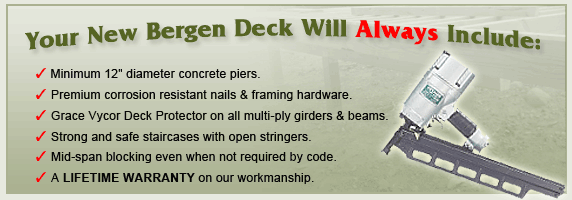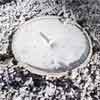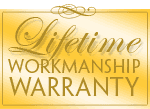
How We Build You a Better Deck
At Bergen Decks, we insist on raising the bar for the sake of our customers. Our experience and continuing education benefits our clients from design through framing and trim. Building decks is a scientific process that should be left to true deck professionals. Call us at (201) 540-9086 or click here to set an appointment for a consultation.

Footings & Piers
 What good is a beautiful deck without a solid foundation? Concrete footings and piers are the critical link between your deck and the ground. We always use a minimum 12" diameter concrete pier on our decks regardless of what the building code dictates. In the case of footings and piers bigger is always better. The load of your deck will be spread over a larger area of earth making your deck less apt to settle over the long term. Our specialized hole excavating equipment will be utilized during this phase of your process.
What good is a beautiful deck without a solid foundation? Concrete footings and piers are the critical link between your deck and the ground. We always use a minimum 12" diameter concrete pier on our decks regardless of what the building code dictates. In the case of footings and piers bigger is always better. The load of your deck will be spread over a larger area of earth making your deck less apt to settle over the long term. Our specialized hole excavating equipment will be utilized during this phase of your process.
Filter Cloth & Gravel (optional)
 On decks less than 8 feet off the ground, we recommend adding an upgrade of the installation of landscape filter cloth and gravel under the deck area to aid in drainage, drying, prevent weed growth, and critter burrows. It is much easier and less costly to add cloth and gravel prior to the deck being installed. We highly recommend this simple upgrade.
On decks less than 8 feet off the ground, we recommend adding an upgrade of the installation of landscape filter cloth and gravel under the deck area to aid in drainage, drying, prevent weed growth, and critter burrows. It is much easier and less costly to add cloth and gravel prior to the deck being installed. We highly recommend this simple upgrade.
Framing Lumber
Today's pressure treated lumber is made to be resistant to rot, decay and insect damage by receiving a variety of chemical applications. The most common framing lumber for decks in our local area is southern yellow pine (SYP) and which has been soaked with alkaline copper quaternary (ACQ) or micronized copper quaternary (MCQ). ACQ was introduced in 1994 as a direct replacement for CCA or Wolmanized lumber due to the environmental and health concerns the widespread use of CCA lumber caused as a result of its high levels of arsenic as a preservative.
Today's treated lumber is durable and safe, however it's main drawback and underlying problem is that the fasteners and hardware that was once used with CCA lumber will decay in a matter of months if used on ACQ or MCQ lumber. Remarkably, this major detail is lost on many so called contractors. Specially coated fasteners and hardware must be used to build with ACQ or MCQ.
Fasteners & Connectors
 ACQ or MCQ treated framing lumber will corrode standard fasteners in as little as a few months under the damp conditions we experience in New Jersey. At the minimum, all fasteners including nails and screws must be hot dipped galvanized to survive being embedded (or even touching) treated lumber. We use high-quality hot dipped galvanized nails from leading industry-recognized fastener producers such as Senco, Bostitch, and Hitachi. We do not use less-expensive off-brand fasteners because they are not coated as well as the more expensive fasteners. Likewise, our framing connectors such as joist hangers, straps, post bases and beam connectors are specially coated to resist corrosion caused by ACQ or MCQ contact.
ACQ or MCQ treated framing lumber will corrode standard fasteners in as little as a few months under the damp conditions we experience in New Jersey. At the minimum, all fasteners including nails and screws must be hot dipped galvanized to survive being embedded (or even touching) treated lumber. We use high-quality hot dipped galvanized nails from leading industry-recognized fastener producers such as Senco, Bostitch, and Hitachi. We do not use less-expensive off-brand fasteners because they are not coated as well as the more expensive fasteners. Likewise, our framing connectors such as joist hangers, straps, post bases and beam connectors are specially coated to resist corrosion caused by ACQ or MCQ contact.
Currently, the best defense against treated wood-generated corrosion is to use stainless steel fasteners and connectors wherever possible. We offer a full stainless steel fastener/connector upgrade package for all of our decks. Currently, stainless steel is the only accepted method of stopping treated wood corrosion. Unfortunately, this is not widely understood. We highly recommend this upgrade on our decks.
Grace Vycor Deck Protector
 During the pressure-treatment, the preservative does not always completely saturate the wood. Fastener holes are also common passageways for water and decay microorganisms. Once subject to water and moisture, framing lumber expands and shrinks, causing more cracks and further exposing untreated areas. Grace Vycor Deck Protector works to preserve pressure-treated wood decks from rot and decay. We use Grace Vycor Deck Protector on all multi-ply girders and beams as a standard practice to prevent water from seeping in between the plys of the girder or beam. We offer additional lumber wrapping of all joists with Grace Vycor Deck Protector as an upgrade for clients desiring additional protection of their deck investment.
During the pressure-treatment, the preservative does not always completely saturate the wood. Fastener holes are also common passageways for water and decay microorganisms. Once subject to water and moisture, framing lumber expands and shrinks, causing more cracks and further exposing untreated areas. Grace Vycor Deck Protector works to preserve pressure-treated wood decks from rot and decay. We use Grace Vycor Deck Protector on all multi-ply girders and beams as a standard practice to prevent water from seeping in between the plys of the girder or beam. We offer additional lumber wrapping of all joists with Grace Vycor Deck Protector as an upgrade for clients desiring additional protection of their deck investment.
Structural Design
We consult a variety of industry-approved sources for specifying the structural components of your deck. Our general rule of thumb is to upsize posts, girders and joists at least one step above the code whenever practical. This provides our clients with a more solid and stable deck structure. Building to the minimums is functional, but we have found that the minimal additional cost of upsizing is well worth it for the longevity and durability of our decks.
We frame our staircases with at least three open stringers (usually a lot more). This method takes a bit longer, but it's the right way to do it. Stairs are no place to skimp yet we are called to replace failing staircases installed by less qualified contractors frequently.
We mid-span block even if it's not required by code. Mid-span blocking stiffens the deck and helps prevent lateral sway. It would be a shame not to do it!


©2010 Fine Home Improvements of Waldwick LLC


